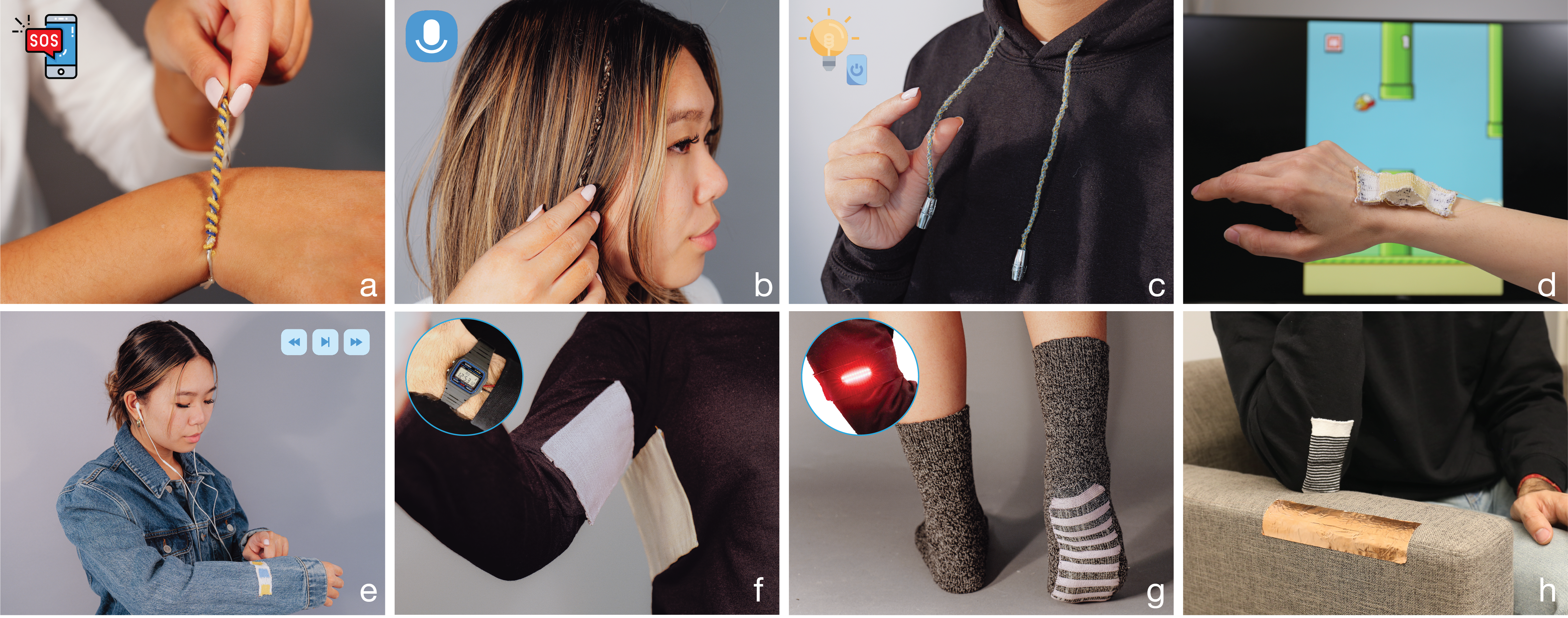TexTENG: Fabricating Wearable Textile-Based Triboelectric Nanogenerators
, Cornell University
🏅Best Paper Award
To Appear in Proceedings of the 2025 ACM Augmented Humans (AH’25)
 Figure 1: We introduce texTENG, a DIY-friendly framework
for fabricating textile-based wearable devices capable of both
sensing and power harvesting on the body. Compatible with diverse
fabrication approaches and commercially available materials, our
menu offers versatility and considerations for the design process.
Our application examples demonstrate (a) an interactive
bracelet for sending emergency messages, (b) a smart hair
extension for activating voice assistants, (c) a
touch-sensitive drawstring for light control, (d) a game
controller utilizing a woven flex sensor, (e) self-powered
touch sensors for music player control, (f) energy storage
from smart garments to power a digital watch, (g) energy
harvesting from smart socks to power running lights, and
(h) wireless interaction enabled by a knit elbow patch.
Figure 1: We introduce texTENG, a DIY-friendly framework
for fabricating textile-based wearable devices capable of both
sensing and power harvesting on the body. Compatible with diverse
fabrication approaches and commercially available materials, our
menu offers versatility and considerations for the design process.
Our application examples demonstrate (a) an interactive
bracelet for sending emergency messages, (b) a smart hair
extension for activating voice assistants, (c) a
touch-sensitive drawstring for light control, (d) a game
controller utilizing a woven flex sensor, (e) self-powered
touch sensors for music player control, (f) energy storage
from smart garments to power a digital watch, (g) energy
harvesting from smart socks to power running lights, and
(h) wireless interaction enabled by a knit elbow patch.
Abstract
Recently, there has been a surge of interest in sustainable energy sources, particularly for wearable computing. Triboelectric nanogenerators (TENGs) have shown promise in converting human motion into electric power. Textile-based TENGs, valued for their flexibility and breathability, offer an ideal form factor for wearables. However, uptake in maker communities has been slow due to commercially unavailable materials, complex fabrication processes, and structures incompatible with human motion. This paper introduces texTENG, a textile-based framework simplifying the fabrication of power harvesting and self-powered sensing applications. By leveraging accessible materials and familiar tools, texTENG bridges the gap between advanced TENG research and wearable applications. We explore a design menu for creating multidimensional TENG structures using braiding, weaving, and knitting. Technical evaluations and example applications highlight the performance and feasibility of these designs, offering DIY-friendly pathways for fabricating textile-based TENGs and promoting sustainable prototyping practices within the HCI and maker communities.
Background: Triboelectric Nanogenerators
texTENG operates based on triboelectric nanogenerators (TENGs), which convert mechanical energy into electricity for sensing and harvesting
 Figure 2: (Left) Operational principle of TENGs;
(Center) Four fundamental operating modes of TENGs;
(Right) Different types of TENGs based on the bonding
between electrodes and tribo layers.
Figure 2: (Left) Operational principle of TENGs;
(Center) Four fundamental operating modes of TENGs;
(Right) Different types of TENGs based on the bonding
between electrodes and tribo layers.
Design Menu
For the fabrication of textile-based TENGs, we have distilled a design menu for user-friendly fabrication.
 Figure 3: Design Menu of texTENG includes
(a) commercially available triboelectric materials and
textile structures for fabricating textile-based TENGs, including
(b) 1D yarn-level structure, (c) 2D textile
structures, and (d) 2.5D textile structures. Materials are
ordered based on our experiments and insights from
Liu et al. (Since separating the electrode from the tribo layer does not
enhance TENG performance, we opted not to incorporate
single-electrode 2.5D structures in our implementation).
Figure 3: Design Menu of texTENG includes
(a) commercially available triboelectric materials and
textile structures for fabricating textile-based TENGs, including
(b) 1D yarn-level structure, (c) 2D textile
structures, and (d) 2.5D textile structures. Materials are
ordered based on our experiments and insights from
Liu et al. (Since separating the electrode from the tribo layer does not
enhance TENG performance, we opted not to incorporate
single-electrode 2.5D structures in our implementation).
Fabrication Methods
Our exploration involved identifying user-friendly fabrication approaches suitable for texTENG.
 Figure 4. DIY techniques for fabricating yarn-based TENGs
(blue and yellow represent positive and negative tribo yarns,
respectively, on the triboelectric series, gray represent conductive
yarns, and purple represent non-functional yarn).
Figure 4. DIY techniques for fabricating yarn-based TENGs
(blue and yellow represent positive and negative tribo yarns,
respectively, on the triboelectric series, gray represent conductive
yarns, and purple represent non-functional yarn).
 Figure 5. Techniques for fabricating (a) 1D
yarn-based TENGs with a DIY braiding tool, (b) 2D
single-layer woven structures, (c) 2D multilayer woven
structures, (d) 2D single-layer knit structures,
(e) 2D knit CS structures, (f-h) 2.5D woven
structures on the floor loom, and (i-l) 2.5D Ottoman Stitch
knit structures
(blue, yellow, purple, and gray represent positive, negative,
non-functional, and insulated conductive yarns,respectively).
Figure 5. Techniques for fabricating (a) 1D
yarn-based TENGs with a DIY braiding tool, (b) 2D
single-layer woven structures, (c) 2D multilayer woven
structures, (d) 2D single-layer knit structures,
(e) 2D knit CS structures, (f-h) 2.5D woven
structures on the floor loom, and (i-l) 2.5D Ottoman Stitch
knit structures
(blue, yellow, purple, and gray represent positive, negative,
non-functional, and insulated conductive yarns,respectively).
BibTex
@misc{batra2025texteng,
title={texTENG: Fabricating Wearable Textile-Based Triboelectric Nanogenerators},
author={Ritik Batra and Narjes Pourjafarian and Samantha Chang and Margaret Tsai and Jacob Revelo and Cindy Hsin-Liu Kao},
year={2025},
eprint={2503.12628}
archivePrefix={arXiv},
primaryClass={cs.HC},
url={https://arxiv.org/abs/2503.12628}
}
Acknowledgements
We would like to thank Heather Kim, Jingwen Zhu, and Pin-Sung Ku for their support and advising during the course of this project. We also would like to thank Melissa Conroy for teaching us the knitting fundamentals and Sam Xia Zeng for assisting us with evaluations.
This page was created using the open-source Tufte Project Template.
Contact
If you have questions about this work, contact Ritik Batra:
rb887 at cornell dot edu.